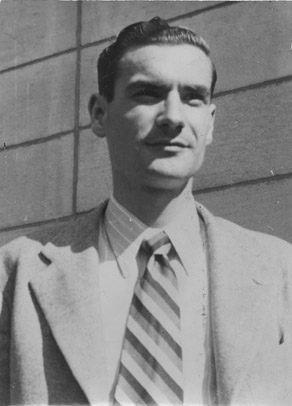

|

|
IN MEMORIAM
Henry J. Lagorio
Professor of Architecture, Emeritus
UC Berkeley
1923-2013
Henry J. Lagorio, a professor emeritus of architecture, died of a stroke on October 1, 2013, following a long struggle with Alzheimer’s and Parkinson’s diseases. His wife, Natalie Croce Lagorio, whom he met in 1960 while on sabbatical in Rome where she was working at the US Embassy, survives him. They married in San Francisco in 1962.
Lagorio was a faculty member in the Department of Architecture from 1947 until his retirement in 1990. A licensed architect and Fellow of the American Institute of Architects, he was a leading researcher on seismic issues related to architecture and urban planning, who lectured, published and consulted widely here and abroad. He served as associate dean of the College of Environmental Design, director of the UC Berkeley Center for Environmental Design Research, and director of the UC Study Center in Italy.
Lagorio was born in Oakland, California, on March 28, 1923, and attended local public schools there. He graduated from Oakland Technical High School in 1940 and, motivated by one of his teachers who suggested he “try architecture,” he enrolled at UC Berkeley the same year, earning a bachelor’s degree in 1944 and a master’s a year later. As he tells the story in Design on the Edge: A Century of Teaching Architecture at the University of California, Berkeley, 1903-2003, following his 1945 graduation and a brief stint as a staff sergeant in the Army, he was in the process of being discharged at Camp Beale in Marysville, California, when he received an unexpected invitation from UC president Gordon Sproul to join the faculty at what was then the School of Architecture.
Long affiliated with the Earthquake Engineering Research Institute, a national society based in Oakland, California, Lagorio was the first architect to serve as the institute’s secretary-treasurer and a member of its board of directors. He also served on many of its key committees as well as the editorial board of its professional journal, Earthquake Spectra.
Professor Lagorio authored one of the few books on earthquakes written specifically for architects, Earthquakes: An Architect's Guide to Nonstructural Seismic Hazards (1990).
In the course of his career he took a leave of absence from Berkeley to work at the National Science Foundation in the earthquake engineering program. There he developed an influential architectural and planning research agenda focused on seismic safety. In 1992 the National Science Foundation awarded him the "Outstanding Performance Award." He was later selected by the NSF to serve as the Secretary of the Civil Infrastructure Systems Task Group which was responsible for the successful development of a new Civil Infrastructure System Research Program with a FY1994 budget of $45.5 million and $54.5 million in 1995.
One of his more special contributions was in the area of earthquake loss estimation methods. He was the first architect to work as a consultant to the National Oceanic and Atmospheric Administration (NOAA) on the development of analytical methodologies for formulating scenarios for the estimation of potential earthquake losses to cities and regions at risk in the US. Today, so many years later, the state of California still applies the principles of this basic model for projecting possible earthquake losses on a state and regional basis. Because of his efforts in this emerging field of research, he was selected to serve as Chairman of the Project Oversight Committee for a multi-year, multi-million dollar research effort to develop a standardized national earthquake loss estimation methodology through the National Institute of Building Sciences for the Federal Emergency Management Agency. He was Advisor/Consultant to the Office of Emergency Services, Executive Office of the President in Washington, DC from 1971-73. He also played an important role in the development of the California "Hospital Facilities Seismic Safety Act."
Professor Lagorio also served as a member of the California Seismic Safety Commission where he was instrumental in developing new safety standards for hospital construction. Nor were his activities limited to the United States:
He participated in various international earthquake reconnaissance field studies after major earthquakes, identifying issues of concern to architects in both design and post-disaster activities of recovery and reconstruction. He participated on teams of world renowned engineers after the earthquakes in Tangshan, China, of 1976, Managua, Nicaragua of 1982; and Campania-Basilicata, Italy of 1984, and received commendations from their governments, thus promoting the legitimacy and importance of architectural involvement in providing an earthquake-resistant environment. In 1995, based on his early efforts, he was selected to serve on the first team assembled by the American Institute of Architects and sent to the Mexico City earthquake site. He was also invited by national and regional governments to study damage to buildings and cities following major earthquakes in Japan and Algeria, and to make recommendations for their strengthening and reconstruction.
Through his pioneering research and his extensive work with academic, professional, and government organizations, Lagorio provided entrée for generations of Berkeley students and colleagues to the international community of seismic experts as well as the cultural and architectural riches of Italy. More than his professional accomplishments though, “Hank,” as he was known to everyone, will long be remembered for his generous and caring mentoring, warm friendship, and unfailing civility. He was, quite simply, a lovely man.
Gary R. Brown